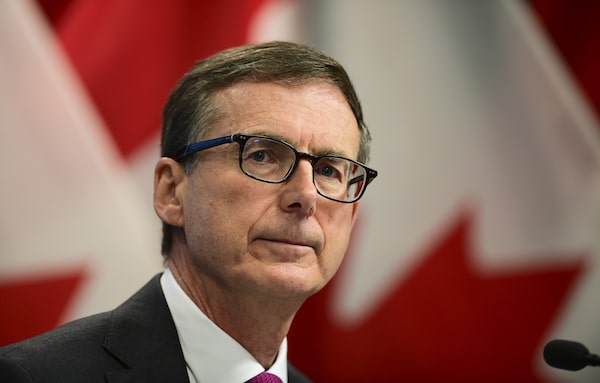
Governor of the Bank of Canada Tiff Macklem.Sean Kilpatrick/The Canadian Press
The Bank of Canada has returned from an eventful summer with a tricky job on its hands: how to communicate vital information while keeping your mouth shut.
On Wednesday, the central bank released its first interest rate decision since July, marking the end of its traditional summer hiatus in which it typically goes quiet and top staff get a bit of a break from the usual grind. No appearances, no speeches, no key reports. The task of setting monetary policy, and communicating it to the Canadian public, takes a vacation.
Governor Tiff Macklem and his colleagues have come back to an economy that grossly underperformed the bank’s own expectations in the second quarter; renewed uncertainty about a COVID-19 pandemic that is tumbling into its fourth wave; and an election campaign in which the bank’s pandemic policies have come under fire. The bank has critics to face and questions to answer.
But it may all have to wait a while longer.
For better or worse, the Bank of Canada has a long-standing practice of staying quiet during political campaigns – a task that has grown more complicated in recent years as the central bank has increased the frequency and detail of its public communications surrounding monetary policy decisions and the state of the economy. Wednesday’s rate announcement hinted that the bank is determined to keep it that way, even as the campaign collides head-on with the bank’s standing communication commitments.
Liberal campaign promise for new bank tax tempers investor expectations
Bank of Canada holds on policy, acknowledges weak recent growth, supply-chain disruptions
The question is just how far the bank can go to communicate its message while being mindful not to say anything that might compromise its political neutrality – especially in a campaign in which key issues such as the housing crisis, rising inflation and government debt financing are thoroughly entwined in Bank of Canada monetary policy. Wednesday’s stand-pat rate decision suggests the bank may not be willing to go very far at all.
While the five-paragraph statement accompanying the decision couldn’t help but acknowledge the surprise contraction of the Canadian economy in the second quarter, and the continued elevated inflation rate, the overall tone was almost self-consciously neutral – positive and negative assessments of various economic factors doled out in equal measure.
Crucially, the final paragraph of the statement – stating the bank’s decision to hold interest rates steady and maintain its current pace of government bond purchases – was identical, word for word, to the previous statement in July.
The bank clearly did not want to give off any hint it was shifting monetary policy even a centimetre in the midst of the heated campaign.
A tougher test of the bank’s tightrope-walking skills will come Thursday, when Mr. Macklem delivers the bank’s usual speech after rate announcements that fall in between its quarterly Monetary Policy Reports. These speeches – four of them a year, delivered by the governor or one of his deputies – were instituted a few years ago to provide more visibility into the bank’s policy deliberations and economic views in the absence of its formal quarterly forecasts.
In normal circumstances, the speech is followed by a news conference. But for the first time since the Bank of Canada launched these post-rate-decision updates, the speech lands in the midst of an election campaign, putting the bank’s standard communications practice in conflict with its preference to sit quietly in the background.
The bank’s compromise is to go ahead with the speech – which was planned months before the election was called – but cancel the news conference. That undoubtedly will sidestep some of the biggest potential landmines the governor might have faced, but the result will be decidedly less informative; these news conferences routinely expose valuable layers of additional detail in the bank’s message.
What remains to be seen is whether Mr. Macklem will take advantage of the speech itself to address, even indirectly, some of the criticisms that have been levelled at the Bank of Canada during the campaign. In particular, elements within the Conservative party have been highly critical of the central bank’s weekly purchases of government bonds, arguing the bank is “printing money” that is enabling a government debt explosion and fuelling inflation.
Recent history has shown Mr. Macklem is willing to take unusual steps to push back against the central bank’s detractors. In July, he wrote a rare op-ed, published in the National Post, defending the bank’s position on Canada’s elevated inflation rate.
But the timing of that article – right before the bank’s summer break, and with whispers in the Ottawa air of a late-summer election – suggests Mr. Macklem wanted to have his say precisely because he knew he would have to hold his tongue now. That pre-emptive strike has given Mr. Macklem cover to stay well clear of political fray, while still delivering a timely, if necessarily incomplete, update of the central bank’s thinking.
In the bigger picture, it’s very much in Mr. Macklem’s interest to keep this speech as uncontroversial as possible. For the bank to pursue its monetary policy objectives, it can’t compromise its political independence by allowing itself to be lured into campaign sniping – even if it is at the centre of that sniping.
Your time is valuable. Have the Top Business Headlines newsletter conveniently delivered to your inbox in the morning or evening. Sign up today.
 David Parkinson
David Parkinson